Integrated Aquaculture by Bearing Ducks on Earthen Fish Ponds
From this study, and for the superiority of th 3rd treatment, it could be concluded that the fish – cum – duck integration system of production is important in producing meat duck and Nile tilapia fish under semi-intensive production system in earthen ponds. But it may gave attention to moderate stocking rate of ducks (125 - 250 duck / feddan) on fish ponds to safe water quality, particularly at low stocking rate of fish, as in the present study (16.8 thousand fry of 4 – 5 g / feddan). Artificial feeding of fish at 25% CP diet at 5 - 4% of fish biomass for 2 months, 4 - 3% for 3rd month, and 3 - 2% at the 4th month (under the integration system) realized the best results in fish growth performance, feed and nutrients utilization, total and prime fish productions with high DM content.
Generally, the non integrated treatments, whether by artificial feeding or organic manure only, were the worst concerning most of the tested parameters. These advantages besides return from ducks and their wastes recommend the integration system fish/duck to improve duck performance and composition as well as total economic return. The microbiological examination was performed for ponds water; duck wastes, fish feed, and fish organs as well. Three different bacterial groups and some pathogenic bacteria were found and counted. All these bacterial genera that found in the tested samples can be completely destroyed by high temperature used in frying and grill.
INTRODUCTION
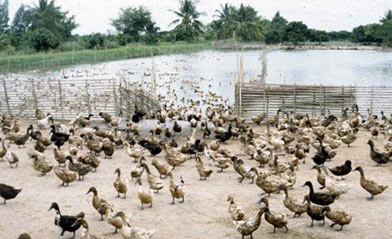 The total Egyptian fish production reached the last year (2006) about 960 thousand ton. About 60% of this production is from the aquaculture, which is belonging mainly to the private sector. Tilapia are the most popular fish in Egypt for their favorable characteristics and production, whether from the wild water bodies or from the pisciculture. Increasing aquaculture activity led to the competition on the conventional feed resources among various animal species.
The total Egyptian fish production reached the last year (2006) about 960 thousand ton. About 60% of this production is from the aquaculture, which is belonging mainly to the private sector. Tilapia are the most popular fish in Egypt for their favorable characteristics and production, whether from the wild water bodies or from the pisciculture. Increasing aquaculture activity led to the competition on the conventional feed resources among various animal species.
However, feed stuffs are the most expensive items in the production, particularly in case of fish. So, recycling of animal wastes in form of non conventional feed stuff for different animal species was and still one of the important aims of the nutritionists all over the world (Abdelhamid et al., 2001). Animal wastes are used too as nutrients source for plants, bacteria, yeasts, algae and zooplankton (Van der Meer et al., 1987). Yet, these wastes may threat the public health (Skovgaard, 1978).
Some countries have a long history of utilizing animal manure for fish farming. Little is known about its effect on environmental sanitation. It is well known that animal manure fertilizes pond water helps increase of fish production. However, it may give rise to pathogenic bacteria and parasites and cause water pollution. Little is known about the effect of animal manure on bacterial diseases in fish and consequently in humans. Freshwater fish in most countries suffer most commonly from bacteria such as Aeromonas spp. and Pseudomonas spp. (Ding et al., 2007). Therefore, the objectives of the present study were to investigate the effects of integrated Nile tilapia fish cultured in earthen ponds with Pekin ducks on pond’s water quality; fish performance, production, quality, and economy; duck performance, quality and economy; and economy of the integrated fish/duck production system.
MATERIALS AND METHODS
This field experiment was conducted in a private farm in Kafr El-Sheikh governorate, Egypt. It aimed to reduce feed costs of fish production under semi-intensive production system via fish/duck integration system.
Experimental Animals:
Three hundred and fifty one-day old Pekin ducklings (each of ca. 90 g body weight) were purchased at a price of 2 LE / duckling. The ducklings were reared for 2 weeks in a closed pen before learning the swimming. Thereafter, they were divided (when reached ca. 225 g each) onto the earthen ponds at variable stocking densities (being 80, 40, 20 and zero on ponds No. 1-2, 3-4, 5-6 and 7-8, respectively) as illustrated in Table 1. The rest of the ducklings were reared in the previous pen as a control and for replacing the death cases from pond’s ducklings. Hormone-sex reversed (mono-sex) Nile tilapia (Oreochromis niloticus) fry (4-5 g) from the hatchery of the same farm were distributed onto the experimental earthen ponds at stocking rate of 4 fish / m2 as given in Table 1.
Experimental Rearing System:
Fish: Eight earthen ponds were sun dried, reformed, and watered from an agricultural drainage. The water (naturally rich in plankton) column (in the ponds) was 1 m height. Six pens were constructed (from wood and reed, 4 x 4 m) on one hand, each on a bank of ponds No. 1, 2, 3, 4, 5, and 6; whereas ponds No. 7 and 8 were offered artificial diet and fresh duckling droppings (from the control ducklings pen abroad of the fish ponds), respectively. Fish of the first 7 ponds were fed on a commercial fish diet (25% crude protein, from a local company for fish diets) in a 3 mm sinking pellets form at variable rates (as shown from Table 1), twice daily, 6 days a week. Whereas, the 8th pond’s fish were given ducks manure only at 10% of the biomass daily for 2 months, 8% for the following month, and 6% at the 4th month. Daily feed quantity offered to the ponds’ fish was modified biweekly according to the actual fish body weight changes.
Table 1: Scheme of the experimental work.
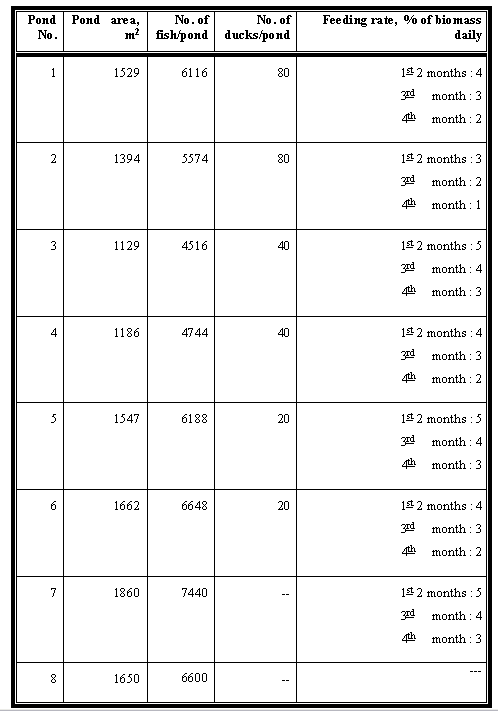
Criteria Measured:
Averages of initial live body weight and length of a fish sample (70 fish) were measured, then biweekly fish weight (0.01 g) and total length (0.01 cm) of fish from each pond (average of 10 fish / pond) were measured. However, the other parameters were calculated after Jobling(1983) and Abdelhamid (2003). Water samples of each pond were measured weekly for temperature, pH, dissolved oxygen (DO) and salinity. Also, DO was measured 3 times daily (dawn 5 am, after noon 2 p.m and at night 10 p.m) for each pond every 3 days.
However, NO3, NO2 and NH4 concentrations were estimated using commercial kits for fresh water. Yet, their levels in the experimental ponds' water were lower than the detectable levels. Another water samples were collected from the experimental ponds (3 samples/pond and preserved by adding chloroform) for phyto-and zooplankton examination, mid the experimental period, using counting cell according to APHA (1992) and Boyd (1992). All water samples were collected from 50 cm depth of the ponds’ water column and from 3 different locations / pond. Proximate chemical analysis for fish, ducks, feed and manure was carried out using the standard methods of analysis (A.O.A.C., 2000).
For microbiological examination, fresh fish samples were collected from all experimental ponds. Five individual fishes were collected from each pond, immediately washed to dislodge extraneous particulate matter. Samples were then sealed in sterile polyethylene bags and stored in ice box until delivered to the laboratory. Also, water samples were randomly collected from all experimental fish ponds. About 250 ml water were taken and 5 ml water from the samples was diluted with 45 ml normal saline water.
All bottles used in this work were immersed in a solutions of 10% HCl for 10 hr, then washed twice with distilled water. The bottles were then rinsed several times in the sample location of the pond with the sample before filling the actual sample. About 20 mg manure was collected and put into a sterilized dark bottle, about 0.5 mg manure sample was diluted with 49.5 ml normal saline water then prepared.
The following cultivation media were the general and specific cultivation media used for different purposes: tryptone glucose extract agar, TGEA, Salmonella / Shigella agar, SS, brucella agar, Baird-parker agar, Psudomonas / Aeromonas selective agar (SA), mannitol salt phenol-red agar, milk agar, Mueller-Hinton agar and nutrient gelatin agar (Merck, 1994) as well as MacConKey agar, Ma (Biomerieux, 1986). Fish samples were sliced under aseptic conditions; one gm was taken from the spleen, intestine or liver for the microbiological examination. Obtained isolates were kept in slants of the same medium at 5oC (APHA, 1992). Slope cultures were considered pure when they showed uniform morphological features by microscopic examination (Collins and Lyne, 1985).
Statistical Analysis:
All numerical collected data were statistically analyzed using S.A.S. (2001) and Duncan (1955) for analysis of variance and least significant differences, respectively.
RESULTS AND DISCUSSION
1- Water Quality Criteria:
Some ponds’ water quality criteria were measured periodically or once (mid the experimental period, e.g. phyto – and zooplankton). All ponds water reflected lower concentrations of NO-3 – N, NO-2 – N, NH3 – N than the smallest increments of the used kits, being 10, 0.2, and 0.5 mg / l, respectively. Ranges of water quality criteria including temperature (ºC), pH values, dissolved oxygen concentration (DO, ppm) and salinity level (ppm) regardless to pond No., i.e. treatments were 22.3 - 29.3ºC, 8.37 – 9.34, 4.41 – 7.05 ppm and 2.86 – 4.85 ppm, respectively.
Although there was no remarkable effect of the treatments on these water parameters; yet, it seams that fish ponds integrated with ducks (ponds No. 1 to 6) reflected warmer water with lower pH values and salinity levels but with higher DO contents comparable with ponds No. 7 and 8 (without ducks). Also, these changes were dependent on the ducks intensity, so were slightly stronger in ponds No. 1 and 2 (80 ducks / pond) than ponds No. 3 and 4 (40 ducks / pond), than ponds No. 5 and 6 (20 ducks/pond). These differences may be due to duck movements on the water surface, which help in enrichment of water with DO from the air. Moreover, the ducks excretion (with its uric acid) lowered the pH values. The movement of ducks on water surface improved the transfer of ambient temperature from and to water, so led to elevating the water temperature.
However, all the obtained water criteria limits were within the suitable ranges recommended for Nile tilapia rearing (Abdelhamid, 2003). Meske (1985) reported that the water temperature must be kept above 24ºC for optimal growth of tilapia. The O. niloticus were found in the great Bitter lakes of Egypt (Kirk, 1972)at salinities between 13.5 and 22.4‰. Chervinsky (1982) cited that the recommended pH for tilapia culture was 7 to 8. The dissolved oxygen concentration of the water was estimated 3 times (dawn, afternoon and midnight) around the day and night for the experimental ponds. As shown from Table 2, there was no effect (P ≥ 0.05) on DO due to the experimental treatments in water measurements of dawn, midnight and the general mean of the three sampling times. Yet, at afternoon, this measurement was significantly (P ≥ 0.05) affected, where the lowest DO concentration was recorded for pond No. 4 comparing with the pond No. 1. Otherwise, there were no significant (P ≥ 0.05) differences among all other ponds.
Generally, this table clearly illustrates the very low DO levels at dawn (2.08 – 2.63) followed by at midnight (3.44 – 4.66) and the highest at afternoon (7.10 – 10.28 ppm). This is a fact because at dawn most of the DO is totally consumed and depleted by breathing of all kinds of alive organisms. At midnight, photosynthesis stopped and DO in water begins to be consumed; whereas at afternoon, all phytocells consumed CO2 and produce O2 which surpasses the breathing requirements of all aquatic organisms. Therefore, the highest DO levels are measured often at afternoons. These findings, are in good accordance with those given by Abdelhamid (2003) and Brune et al. (2003). A reason for raising pH by organic fertilizer is removal of CO2 through photosynthetic activity yet, fertilization plus artificial feeding did not influence electrical conductivity (EC) of ponds water, although the increase of organic fertilizer rate increased EC (El-Sayyad, 2007).
Table 2: Means of the dissolved oxygen level (ppm) in ponds water as affected by the experimental treatments and time of sampling
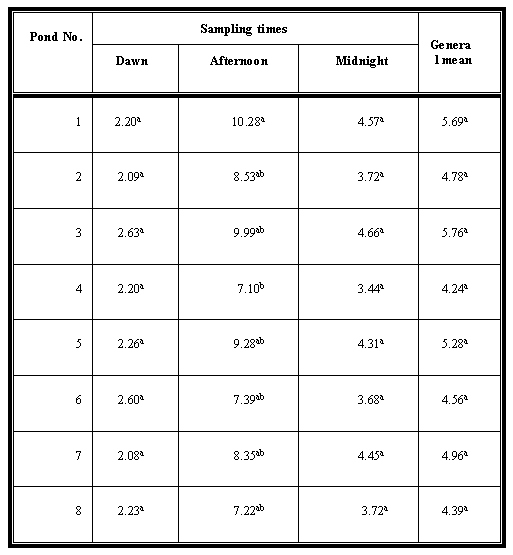
a–b: Means in the same column superscripted with different letters significantly (P ≥ 0.05) differ.
Although there were no significant (P ≥ 0.05) differences among the experimental ponds in the phytoplankton count as a total and as euglina, green and blue green algae (Table 3); yet, there were remarkable (P ≥ 0.05) changes in zooplankton number, whether as a total, nauplii, rotifers, cladocerans, copepods or larvea (Table 4); where ponds No. 7 and 8 contained the lowest total numbers of zooplankton, rotifers, cladocerans and larvea per liter of fish rearing water. Bacteria decompose organic materials, mineralizing them into nutritional inorganic materials, which can be utilized by phytoplankton. Fish – cum – duck integration could result in good economic efficiency of fish. This pattern was formed incidentally in 1934, where the German scientist Probst conducted scientific experiments of integrated fish – cum – duck farming for the first time. He raised ducks in common carp fish ponds and found that 0.9 – 1.7 Kg of fish could be increased by raising one duck (Jian, 1985).
Soliman et al. (2000) mentioned that there were no differences in temperature or pH in any of the ponds but dissolved oxygen levels were lower in integrated ponds concomitant. Hafez et al. (2002) found that poultry litter for 60 days followed by artificial feeding led to lower dissolved oxygen and pH value and higher alkalinity and phosphorus; yet, it was responsible for higher chlorophyll (a) and zooplankton as well as higher daily gain of tilapia than the control (artificial feeding only). However, Lu et al. (2004) reported that euglena is one of freshwater algae which is acceptable as a diet for larval Nile tilapia.
Table 3: Means of phytoplankton count per liter of water as affected by the tested rearing systems of Nile tilapia in integrated system
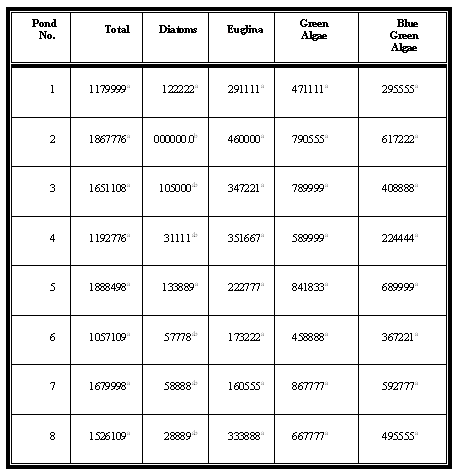
a-b: Means in the same column superscripted by different letters significantly (P ≥ 0.05) differ.
Table 4: Means of zooplankton count per liter of water as affected by the tested rearing systems of mono sex Nile tilapia in integrated system
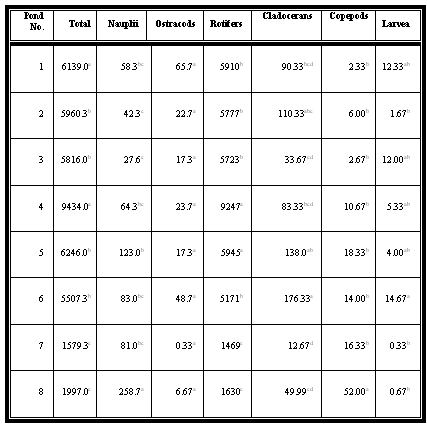
a–d: Means in the same column superscripted by different letters significantly (P ≥ 0.05) differ.
In order to detect and count of pathogenic bacteria in pond water, the water samples were conducted using different cultivation media and obtained results are recorded in Table 5. From the tabulated data, one can see that in pond No. 8 Pseudomonas / Aeromonas medium (SA) gave the highest count being 113 x 106s cfu / ml, followed by SS agar medium giving 58 x 106 cfu / ml. The first cultivation medium (SA) gave a good picture about Pseudomonas spp. and Aeromonas spp. while the second medium specific for detecting of Salmonella spp. and Shigella spp. As reported by Ray (2001), all strains of Shigella spp. and Salmonella spp. are considered pathogen, but only the pathogenic strains of E. coli (Ma medium) are associated with food borne illness. This may be demonstrated by the presence of sewage in pond water. So, Goosney et al. (2001) reported that bacterial pathogens can survive and persist in sewage contaminated water to exploit their host’s cellular processes to mediate their effects extracellularly or intracellularly.
In case of Macckoncy (Ma medium), pond No. 7 gave the highest numbers of coliform bacteria. Regarding Brucella spp. (Br medium), the numbers were low in all tested ponds except ponds No. 7 and 8 since the count was 18.3 x 106 cfu / ml for each. For detection of Micrococcaceae members, the Baird-Parker agar medium was used (BP). Ponds No. 3, 4 and 6 exhibited the highest values in decreasing order being 21.3, 18.7 and 15 x 106 cfu / ml of the tested water. Regarding MS medium for Staphylococcus spp., only ponds No. 7 and 8 gave high member to be 14.7 and 16.0 x 106 cfu / ml, respectively. These data can suggest that these bacteria reached the ponds with feed of fish, or with the pollutants came with water, or they were added to the pond water with the duck manure.
Abd Elaziz and Ehab (2003) found that using poultry droppings as a feed for cultured tilapia led to increases in water concentrations of NH3 and NH4 and a decrease of DO level. It increased also % of positive water samples for Salmonella, Staph, Shigella sp. and Campylobacter. This treatment was responsible too for increased positive samples (%) of tilapia for Pseudomonas, Salmonella and Shigella in muscles and kidney of fish and for Pseudomonas, Salmonella, Staph, Shigella and Campylobacter in the fish intestine. All these bacteria were found in the poultry droppings. Additionally, Ampofo and Clerk (2003) mentioned that the use of animal wastes to fertilize pond farms as practiced in many countries is considered superior to inorganic fertilizers in producing and maintaining desirable species of planktonic and benthic organisms and to enhance fish production.
As manure causes organic enrichment, it may also hasten the deterioration of the water quality making the aquatic environment favorable for the growth and multiplication of human pathogenic bacteria. Pathogenic bacteria such as Aeromonas, Citrobacter, Edwardsiella, Enterobacter, Escherichia coli, Klebsiella and Serratia may be introduced into the aquatic environment.Mean most probable number of total coliforms, faecal coliforms, and faecal Streptococci of water samples per ml from ponds treated with chicken manure were 1.4 x 106, 2.6 x 103, and 3.2 x 103, respectively, while these values from water of control ponds were 6.0 x 103, 1.9 x 102, and 2.8 x 102, respectively (Abdel-Rahman et al., 2004). There is a pollution with pathogenic bacteria (Salmonella, Shigella and E. colli) in fish rearing water of the tested locations (Abdelhamid et al., 2006). Aeromonas hydrophila was the most pathogenic organism in fish ponds’ water followed by Pseudomonas fluorescence and Streptococcus faecales with an incidence of 26.6, 20.0 and 13.3%, respectively (El-Genaidy and Yousseff, 2007).
Table 5: Count of pathogenic bacteria in ponds' water samples

Because of addition of fish feed and duck manure in the pond water in applied system, the bacteriological examination should be taken into account. The pathogenic bacteria were also detected using the eight specific cultivation media and obtained results are shown in Table 6. The most incidence bacteria was Pseudomonas spp. and Aeromonas spp. being 38.7 x 106 cfu / g (SA medium). Salmonella spp. and Shigella spp. were also counted to be 16.7 x 106 cfu / g. Brucella sp., Micrococcus sp. and Staphylococcus sp. were also found in 7.7, 11.3 and 9.0 x 106 cfu / g, respectively in the fish feed. Data showed that Pseudomonas spp. and Aeromonas spp. the highest incidence percent being 63.7 x 106 cfu / g. The G- short rods of Enterobacter riaceae such as Salmonella spp. and Shigella spp. (SS medium) came in the second order to be 44.0 x 106 cfu / g. E. coli and coliform groups were also detected in duck manure sample. Brucella sp., Staphylococcus sp., and Micrococcus were also found in the duck wastes.
Table 6: Count of pathogenic bacteria in fish feed sample
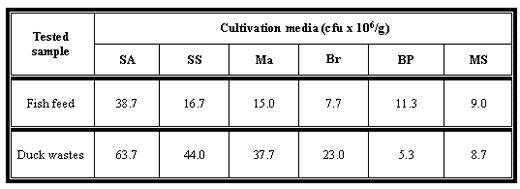
Abel-Rahman et al. (2004) reported the most probable number of total coliforms, faecal coliforms, and faecal Streptococci of chicken manure (used as fertilizer for fish ponds) samples per gram as 4.5 x 108, 1.9 x 105, and 1.9 x 106 respectively. They suggested that chicken manure should be treated before applying to fish ponds to lower the possibilities of contamination with pathogenic bacteria. Moreover, it is well known that Salmonella is responsible for poisoning of poultry and humans (Anon., 2004). In addition, it is subsequently recovered from processed fish products (Guerin et al., 2004). Recently, Abdelhamid et al. (2006) proved that aquafeeds are contaminated with pathogenic bacteria (Salmonella, Shigella, and E. colli).
2- Fish Production:
The initial live body weight and total length as well as condition factor of the fish did not differ significantly (P ≥ 0.05) among various experimental ponds (Table 7). Yet, there were significant (P ≤ 0.05) effects of the treatments on final body weight, body weight gain, and final total body length of the experimental fish. Where pond No. 3 reflected significantly the heaviest final body weight, body weight gain and longest total body length. Ponds No. 1 and 4 did not differ significantly with pond No. 3 concerning the superiority of their fish final body weight and body weight gain. This means that the best treatment concerning fish performance was 4 fish/m2 with daily feeding rate of 5% for 2 months followed by 4% and 3% for the 3rd and 4th month, respectively combined with 40 ducks / pond (pond No. 3).
Similar with pond No. 1 (80 ducks / pond) and pond No. 4 (40 ducks / pond) at daily feeding rates in both ponds as 4, 3 and 2% during 1st two months and 3rd and 4th month, respectively (Table 1). However, the worst treatments were those of pond No. 8 and pond No. 7. They gave the lowest values (P ≤ 0.05) for final body weight, body weight gain and final total length of their fish. This means that artificial feeding alone (even at high daily feeding rate, being 5, 4 and 3% of the biomass during the 1st 2rd, 3rd, and 4th month, respectively) were not sufficient as feeding plus duck integration, even at the lowest stocking density of 20 ducks/pond in ponds No. 5 and 6.
Table 7: Nile tilapia performance* as affected by the experimental treatments in the earthen ponds throughout the 120-day experimental period.
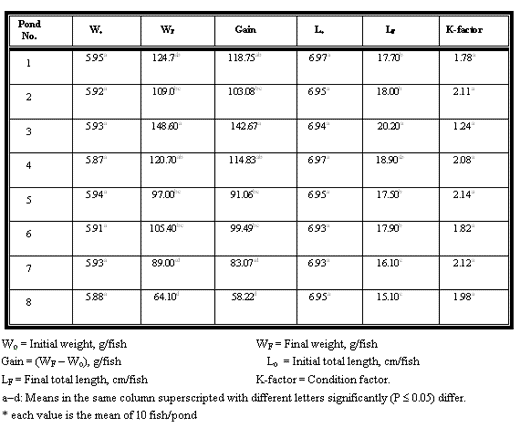
Table 8 shows that there were significant (P ≤ 0.01) variations among the experimental treatments. Once again, pond No. 3 gave fish with the best (P ≤ 0.05) average daily gain (ADG) and specific growth rate (SGR), being 594.46 mg, 1.32%/day, respectively. Pond No. 1 was similar (P ≤ 0.05) to pond No. 3 concerning ADG and SGR. The worst treatment was that of pond No. 7 taking the same trend as in fish performance criteria (Table 7). However, the best (false) values of FCR, PER, PPV and EU for pond No. 8 assuming that its fish consumed the duck manure as direct feed. Although, the manure was given only during the days where the water turbidity was decreased. Additionally, the primary productivity was not taken in consideration since the water was drainage and very rich in natural food. Moreover, these findings highlight the importance of fish/duck integrated system in increasing fish performance in earthen ponds.
Table 8: Means of some parameters of growth and feed and nutrients utilization of Nile tilapia fish throughout 120-day experimental period as affected by the experimental treatments.
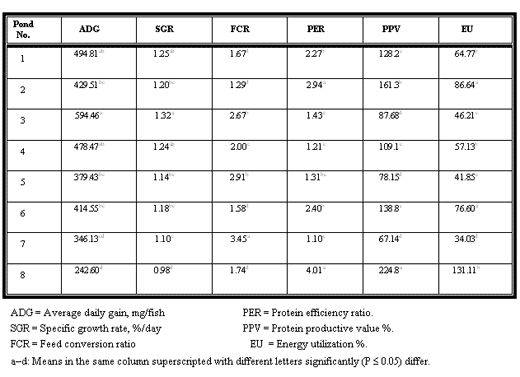
Zhu et al. (1990) pointed out that the conversion ratio increased with the increase of pig manure inputs, it was 1.8 at the rate of 10 Kg/ha/d while it reached 4.8 at the rate of 48 Kg manure/ha/d. However, tilapia fed directly on algae or zooplankton, which feed on algae (Knud-Hansen et al., 1993). Combining fertilization and feeding moderate water quality and produce rapid growth (Diana, 1997). Also, Amer (2000) showed that the organic fertilization and supplemental feeds is better than the artificial feed only to get more utilization of the artificial feed and to improve FCR. Supplemental feeds are commonly used in ponds culture to increase fish growth and yield (Li and Yakupitiyoge, 2003). Since El-Tawil (2006) stated that natural food resulted from fertilization had higher contribution in fish nutrition.
Also, high fertilization rate with low feeding rate resulted in better FCR (El-Sayyad, 2007). In an another study, in the same private farm, Abdelhamid and Ibrahim (2003) reported 1.10 – 1.46 g / fish as average daily gain, 1.14 – 1.22%/d SGR, 1.06 – 1.70 PER, 51.8 – 118.5% PPV and 2.33 – 3.74 FCR for mono sex Nile tilapia. Recently, Abou Zied (2007) proved that Nile tilapia reared in the integrated ponds with duck exhibited better body weight and feed conversion than those of the non-integrated ponds.
Jian (1985) identified the so-called “integrated fish farming” as diversification, overall rural development and comprehensive utilization of fisheries, agriculture, forestry and commerce, with emphasis being placed on fisheries. It is a model of farming system for full utilization of local resources, for waste recycling and energy saving, and for maintaining ecological balance and circulation. Besides increasing the supply of fish, meat and eggs, and employment opportunities, it also reduces the cost of fish production through utilization of local farm products as fish feeds and fertilizers and reorganization of farm labor for effective output. Moreover, feed supplementation to manure ponds led to significant increase in fish weight and yield (Abdel-Gawad et al., 2003), the increase was improved too by increasing feeding rate of the supplement (Middendorp, 1995).
However, organic fertilization stimulates the development of bacteria in the water which not only accelerate the decomposition of organic matter, but also serve as food for the zooplankton (Table 4), which form the nutritious and preferred food for many aquaculture species (FAO, 1996). Since organic fertilizer benefits the growth of bacteria and benthos, thus provides supplementary food for zooplankton and fish (Schroeder, 1978). Also, Sophin (2007) cited that duck manure (production per adult, being 0.05 ton / year) has similar C/N ratio as in chicken manure, being 18. He added that addition of manures to the pond can increase fish production by two main pathways, by direct consumption by the fish and/or by the increase in natural food (phyto-and zooplankton as well as benthos) due to the release of nutrients from the decomposition of the manure. So, the range of manure loading used in fish ponds from meat ducks were 150 – 600 Kg / day /ha, and the conversion ratio of manure to fish is 15 – 25 (Kg fresh duck manure/Kg increase in weight of fish) according to STOAS (1993).
Table 9: Nile tilapia fish production and its classification as affected by the experimental system at the end of four months rearing period in Kg / feddan* (and % of the production).
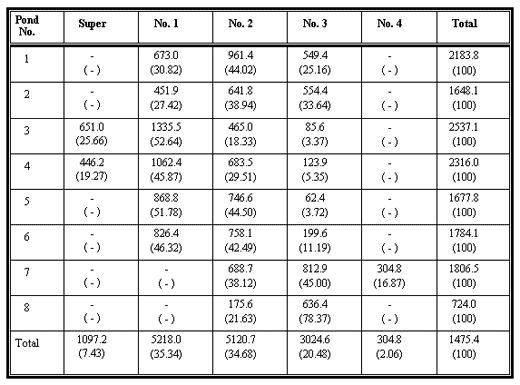
* One feddan (an Egyptian area unit) equal 4200 m2.
Abdel-Hakim et al. (2000) found that total Nile tilapia production for duck manure (DM) treatment was lower than that for DM + artificial feed (DM + F) treatment. The DM + F treatment increased significantly the final fish weight, average daily gain and survival rate, beet reduced the net returns over costs because of the fish feed which did not enhance the growth of fish to cover the feed costs. However, feed costs in the aquaculture are about 30 – 85% of the total changeable costs, according to the degree of intensification (Wet and Linde, 2007).
However, food is one of the chief vehicles of gastrointestinal disease, and limits have therefore been established for the numbers of pertinent categories of microorganisms tolerable in various foods. Ampofo and Clerk (2003) found the total heterotrophic bacterial count of fish feeds as 0.7 x 103 – 1.9 x 104/g. The count for the organic fertilizers ranged from 1.4 x 106 to 7.3 x 106/g. The most probable number (MPN) per gram of coliforms of the organic fertilizers was significantly greater than those of the diets, and ranged from 1.1 x 104 to 9.3 x 104/g an < 1 – 1.4 x 103/g for total and fecal coliforms, respectively. Total coliform counts for the diets ranged from 1.1 to 1.1 x 102/g. Enterobacteriaceae were detected in the feeds and organic fertilizers with the MPN being far superior for the organic fertilizers. Farmers using these materials must be aware of the presence of the bacterial flora, as they will contribute to the fish environment.
The lowest (P £ 0.05) crude protein (CP) content was associated with significantly high ether extract (EE) content in the fish of pond No. 8. Yet, pond No. 3 fish contained the highest (P £ 0.05) dry matter (DM). However, there was no specific trend for the variations among the experimental treatments in the chemical composition of the whole fish body of the experiment (Table 10). Generally, dietary effects on fish body composition have been reported by many investigators (Page and Andrews, 1973). Ayyat et al. (2000) reported that increasing dietary protein level from 20.6 and 25.7 to 31.5% increased its digestibility and fish body gain as well as improved feed conversion and final margin besides increasing fish body protein and reducing fish body fat; yet it reduced protein efficiency by Nile tilapia fish. Negative relationship between CP and EE was reported frequently in tilapia fish (Abdelhamid and Ibrahim, 2003 and Abdelhamid et al., 2004 and 2005-a & b).
Table 10: Chemical analysis of the whole fish at the start and at the end of the experiment as affected by the treatments.
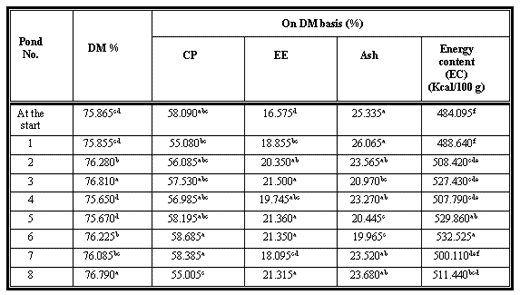
a–f: Means in the same column superscripted by different letters significantly (P ≤ 0.05) differ.
Carcass crude protein of grey mullet, silver carp and tilapia was improved in the integrated system. The data on return on sales, return on costs, return on equity, pay-back period and break-even point showed that the integrated system was more profitable than the non-integrated system (Soliman et al., 2000). Also, Abdel-All et al. (2001) working on Nile tilapia for 5 months in earthen ponds. Fish from ponds fertilized by poultry manure for 60 days followed by artificial feeding gave higher dressing percentage, flesh percentage, return and lower by-products percentage than the control (artificial feeding only).
Table 11: Fish performance and productivity of the experimental earthen ponds of Nile tilapia fish during 4-month rearing period, calculated per feddan.
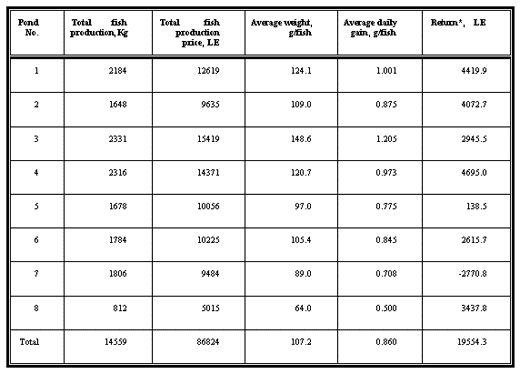
*Price of one ton diet was 1850 LE, price of one Kg tilapia fish of super class, No. 1, No. 2, No. 3 and No. 4 was 7.2, 6.25, 6, 5 and 5 LE, respectively, and price of 1000 fry was 60 LE. Including duck manure price (130 LE/m3, m3 = 100 Kg, Abdelhamid, 1991) assuming that the duck spent half time on the ponds (130 g manure/duck/day for 2 months). Average body weight of tilapia class super, No. 1, No. 2, No. 3 and No. 4 was 179, 147, 111, 79 and 55 g, respectively.
In this connection, net return was highest for fish produced with chicken manure in integrated system than for fish produced with collected chicken manure (Engle and Skladany, 1992). Since fish yield when ducks were combined with fish on the ponds was 4 times that when using only manure as nutrient, besides the accumulative live mass yield of ducks (Schoonbee and Prinsloo, 1998). From other studies, it is concluded that rearing Nile tilapia in earthen ponds with low level of organic fertilizer gave the best growth rate and optimum fish production with a high level of profitability (Abdel-Tawab and Sweilum, 2004).
One entire season of 7 months can produce more than 7 tons of fish and introduce a net income of more than 12.000 LE/feddan under the same farm conditions used in the present study (Abdelhamid and Ibrahim, 2003). The variations among these results may be attributed to: water quality, feeding regimes, initial fish weight, stocking density of fish, feed quality, rearing duration, fish selling weight, and/or market prices of fish and feeds. Abou Zied (2007) recently also confirmed that fish yield/fed and economic efficiency produced from the integrated ponds were significantly higher than those obtained from non-integrated ones.
In order to count and detect of pathogenic bacteria, the fish organs samples were conducted using different cultivation media and obtained results are recorded in Tables 12 - 14. Generally, Pseudomonas / Aerpmonas (SA) medium gave the highest count of Pseudomonas spp. and Aeromonas spp. after the Baird – Parker agar medium (BP). The second medium BP gave number of Staphylococcus spp., Bacillus spp. and Micrococcus spp. A large number of bacterial disease occur in fish farms as reported by Noga (1996). Among the bacterial disease encountered in fish, Pseudomonas sp., which has been well documented as a cause of considerable economic loss to fish form (Drumedz and Lio-Po, 1985).
In addition, either SS or Ma cultivation media has given an appreciable count of Salmonella spp., Shigella spp. and E. coli. All these three genera are belonging to the family Enterobacteriaceae which capable of inducing gut-wrenching gastroenteritis as reported by Anon.-b (2005). The incidence of diagnosed infections for pathogens was increased for E. coli and Shigella spp. but decreased for Salmonella spp. as shown in Colorado (2001).
Consumption of raw seafoods may results in foodborne illness, therefore about many million foodborne illness, or food poisoning cases occur by E. coli, Salmonella spp. and Shigella spp. as shown by PHSKC (2005). Also, uncooked or sewage contaminated foods can cause infection, particularly, seafoods may cause acute diarrhea due to Salmonella contamination (Pizzo et al., 1982). That could indicate the presence of human pathogens that may be hazardous to fish handlers and consumers and this leads to the importance of microbiological safety which should be considered in fish farming (McKeon et al., 2000). Nevertheless, no clinical signs were appeared during these experiments. The explanation can be demonstrated by the term probiotic, which has been defined as a probiotic of mono-or mixed culture of live microbes that applied to man or animal.
These bacteria can affect beneficially the host by improving the properties of the indigenous micro flora as reported by Havenaar et al. (1992). So, one can suggest the presence of some microbes such as sporeforming G+ long rods bacteria can do this role against the pathogenic bacteria such as E. coli, Salmonella spp., Shigella spp., Pseudomonas spp., Aeromonas spp. and Staphylococcus spp. In addition, the analysis of variance was carried out to examine the effect of specific cultivation media with different treatments on the tested samples either spleen, intestine or liver. Data show no significant differences between the cultivation media for all treatments used in case of spleen. On the other hand, the mean values of the bacterial count of fish spleen samples by using the cultivation media as affected by different treatments were also calculated. No significant differences were found for each cultivation media on the eight treatments, except some cases.
Table 12: Mean values of the bacterial count (cfu x 106/g) of spleen using specific cultivation media as affected by different treatments
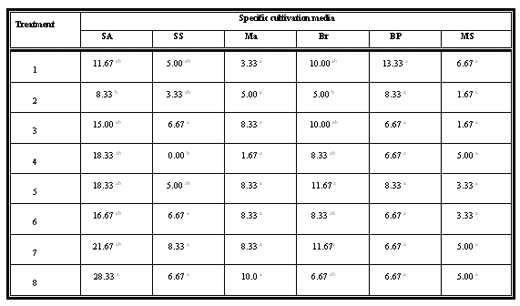
a–b: Means in the same column superscripted by different letters significantly (P ≤0.05) differ.
Furthermore, the same observation and similar trend was found in case of either intestine or liver as can be seen in Tables 13 and 14, respectively. It worthy to note that the addition of fish feed and duck wastes led to increase the microbial load of ponds’ water. Furthermore, the temperature, DO, pH value and content of organic matter of pond water can stimulate the propagation of microorganisms (Bilodeau et al., 2003). Lamada et al. (2000) detected Pseudomonas organisms in 68% of Nile tilapia fish samples. The total Pseudomonas count in average was 5.46 x 102 – 1.10 x 102. They isolated also Aeromonas organisms for 38% of the examined samples. The total Aeromonas count was in average from 4.9 x 102 – 0.88 x 102. Fish samples from ponds treated with chicken manure showed mean most probable number of total coliforms, faecal coliforms, and faecal Streptococci per gram to be 4.8 x 104, 5.2 x 103, and 5.4 x 102, respectively, while those of control ponds were 3.5 x 103, 2.6 x 102, and 1.2 x 102, respectively (Abdel-Rahman et al., 2004).
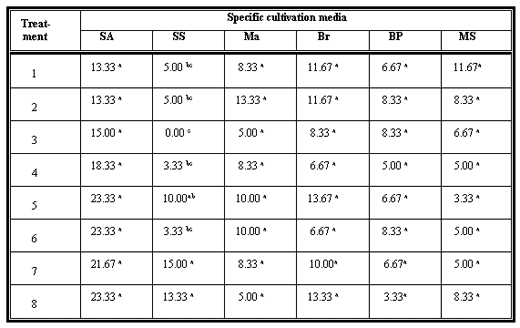
a–c: Means in the same column superscripted by different letters significantly (P ≤ 0.05) differ.
Moreover, Ali and Ibrahim (2004) reported significant increases for all counts of enterobacteriaceae, Pseudomonas and/or Aeromonas spp. in fish muscle tissue and water samples after the addition of poultry droppings. Salmonellae (28%), Yersinia enterocolitica (36%), Pseudomonas aeruginosa (40%), Aeromonas hydrophila (16%), and Campylobacter jejuni (28%) could be isolated from fish after the addition of poultry droppings.
Therefore, fish may cause food poisoning for its bacterial contamination, particularly with Salmonella and Shigella (Anon., 2005-a) as well as Yersinia (Haggag and Saad, 2006). Aeromonas hydrophila, Pseudomonas fluorescence, V. anguillarum, and Streptococcus faecales were the most pathogenic organisms in Nile tilapia fish with an incidence of 49.4, 32.5, 6.7 and 8.3%, respectively (El-Genaidy and Yousseff, 2007).
Recently, Abdelhamid et al. (2006) found that wild as well as cultured fish are contaminated with pathogenic bacteria (Salmonella, Shigella, and E. colli) mainly in summer season. They added that there was significant effect of either season or sampling locations on the total bacterial count (TBC). Also, there were positive and significant correlations between TBC, on one side, and each of fish body measurements (total length, depth, and weight), on the other side.
Table 14: Mean values of the bacterial count of liver using specific cultivation media as affected by different treatments

a–b: Means in the same column superscripted by different letters significantly (P ≤ 0.05) differ.
3- Duck:
Table 15 shows some performance parameter of the experimented ducks on the first six ponds in the integration system with fish in comparison with the control ducks in the dry pen. Ducks on water ponds performed more better than the ducks in the closed pen (control), particularly on ponds No.5, (the lowest duck stocking, being 20 ducks per pond), 1 and 2, respectively (P ≤ 0.05). Ducks on these three ponds gave significantly heavier final body weight. Also, ducks on ponds No. 1 and 5 realized the highest (P ≤ 0.05) dressing weight comparing with the control ducks.
However ducks of pond No. 5 gave also, higher (P ≤ 0.05) weights of feathers, bone and undeniable parts comparing with the control ducks. Ducks on pond No. 1 reflected the highest (P ≤ 0.05) boneless meat weight and liver weight (as in ducks of pond No. 5); whereas, ducks of pond No. 5 presented the heaviest (P ≤ 0.05) weight gain of ducks comparing with the control. However the best gizzard weight was given by ducks of integrated system on pond No. 1 (Table 15 cont.).
Men (1995) mentioned that duck and fish production has been expanding and contributes to increased income and improved living standards of the farmers, especially for poor farmers in the remote reveal areas. In some regions, farmers raise fish on animal manure and obtained good results with fast growth of the fish. However, public health concerns have been raised about the integration of poultry and fish production on several levels. The risks of direct pathogen transfer to humans in fishponds fertilized with manners, whether consumers, producers or intermediaries, have been most assessed (Buras, 1993). Ducks are very growing animals in short duration, with good feed conversion to edible meat. But duck slurry is also another source of money in duck production system. Since duck slurry is utilized as an organic fertilizer and as a renewable energy source (Murray, 2005).
Table 15: Data of ducks out (control) and in water system (ponds No. 1 – 6) at the end of the experiment (2.5 month).
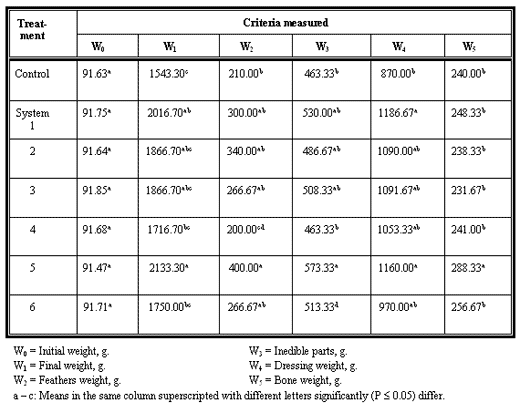
Table 15: Continue
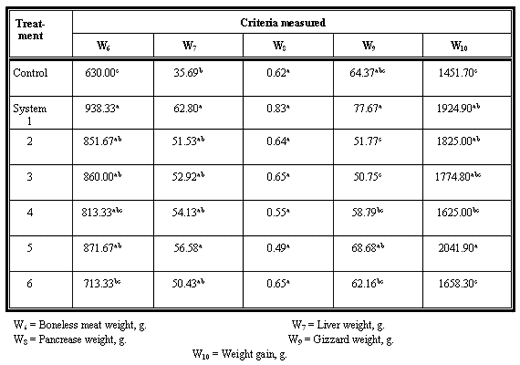
a – c: Means in the same column superscripted with different letters significantly (P ≤ 0.05) differ.
Proximate chemical analysis of duck tissues proved that the integration system at highest stocking rate of ducks (80 duck/pond an ponds No. 1 and 2) increased thigh muscle protein content and decreased its fat and ash contents significantly comparing with the other two stocking rates of 40 and 20 duck/pond, i.e. ponds No. 3 – 4 and 5 – 6, respectively (Table 16). So, ducks on ponds No. 1 and 2 had similar thigh composition to that of the control ducks. The breast (Table 17) of ducks had naturally lower fat content than the thigh. Yet, the same trend of the significantly better composition of thigh of ducks at the highest stocking rate, being 80 ducks/pond, was repeated again in the breast composition. Where the significantly (P £ 0.05) higher protein percentage and lower ether extract and ash percentages were found in ducks of the integration system on ponds No. 1 and 2 similar to the control ducks but better than the breast muscle composition of ducks on the ponds No. 3 to 6. Anyhow, the negative relation between crude protein and ether extract percentages are often reported in tissues of different animal species (Abdelhamid, 1982 and Abdelhamid et al., 2002).
Table 16: Data of chemical analysis of thigh muscles of the ducks as affected by the integration system.
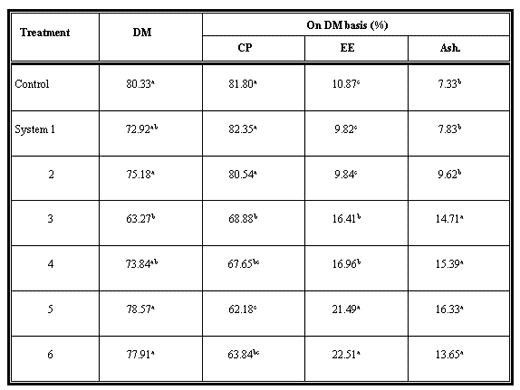
a – c: Means in the same column superscripted with different letters significantly (P ≤ 0.05) differ.
Table 17: Data of chemical analysis s of ducks’ breast muscles as affected by the integration system.
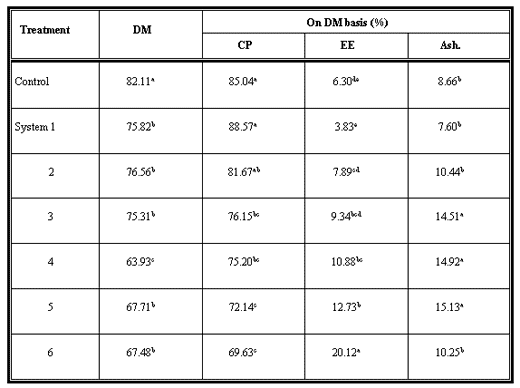
a – e: Means in the same column superscripted with different letters significantly (P ≤ 0.05) differ.
The return due to duck selling depended on the stocking rate of ducks on the fish earthen ponds. So, it was better from ponds No. 1 and 2 than from ponds No. 3 and 4 than from ponds No. 5 and 6 where the stocking rates were 80, 40, and 20 duck/pond, respectively. In general, this return from duck selling is an additional value to the main product, being fish. Moreover, duck excreta is a price valuable for its use as fresh manure for pond No. 8. Since recycling of animal wastes is beneficial for the primary productivity (natural food) in ponds’ water (Abdelhamid, 2003), as well as in animal feeding (Abdelhamid et al., 2001).
4- Fish – cum – duck production economy:
Table 18 illustrates some economic evaluations of the integrated production system (fish – cum – duck) tested herein in LE/feddan/4 months. It is clear from total return from selling both fish and duck production that the best treatment was the 1st followed by the 4th, 2nd, 8th, 3rd, 6th, and 5th, being 5771.5, 5566.9, 5555.1, 3720.2, 3597.8, 2949.4 and 472.4, respectively. Whereas the 7th treatment realized loss of 2635.4 LE/feddan/4 months for its dependence totally on the artificial feed for fish without integration with duck, since fish marketing in this case is a sole source of return. So, it realized the highest working rate (1.278) and the lowest percentages of return/outputs (-27.5) and outputs/inputs (78.3).
The 8th treatment also was not integrated with duck, so there is no return from duck marketing; yet, its total return (from fish selling only) was higher than treatments No. 3, 5, 6 and 7 because there was no feeding costs (manure only), thus it was very economic, with lowest working rate (0.258) and highest percentages of return/outputs (74.19) and outputs/inputs (387.4), among the 8 tested treatments (ponds). So, organic manure only for earthen ponds is economic beneficial, but artificial feed only for ponds fish is undesirable and even caused loss of money, at least, under the experimental conditions of this experiment.
Table 18: Fish – cum – duck farming profitability* per feddan in LE.

Meanwhile, 250 duck/feddan in integration system (ponds No. 1 and 2) was a good treatment, not only in total return, but also in return/outputs % and outputs/inputs %. However, ducks are grown on ponds at a density of 300 – 600/acre. Ducks that are raised on ponds remain healthier than land-raised ducks. Also, by raising ducks on ponds, feed wasted by the ducks is consumed directly by the fish (Rakocy and Mc Ginty, 1989). Jian (1985) raised ducks on common carp fish ponds and found that 0.9 – 1.7 Kg of fish could be increased by raising one duck. El-Sayed (2006) cited that farming tilapia with ducks is the most successful integrated culture. He added that the type and density of ducks significantly affect fish growth and yield as well as water quality.
Payer (2001) mentioned that ducks and goose are bred with fish since thousands of years in subtropics such as Egypt in its Nile and Nile Delta as an old tradition. He added that there are 9 million ducks in Egypt at 1999. Concerning integrated agriculture – aquaculture technology (duck – fish culture), the same author cited that benefits of ducks include high fish production, producing valuable eggs and meat, loosen the pond bottom, releasing nutrients which increase pond productivity without labor for spreading manure, and get 50 – 75% of their feed from the pond in the form of aquatic weeds or insects and mollusks. Each feddan requires 84 – 126 ducks.
Nile tilapia yields in organic fertilization plus formulated feed treatments were significantly greater than the yield from chemical fertilization ponds. A larger percentage of harvested tilapia in the organic fertilization plus feed treatments were classified in the first and second class size categories compared with the traditional Egyptian system. Organic fertilization plus formulated feed ponds management strategies had the highest net returns, average rate of return on capital and the highest margin between average price and break – even prices to cover total variable costs or total costs (Green et al., 2002).
by A.M.Abdelhamid 1, H.A.Al-Fadaly 2, and S.M.Ibrahim 1
1 Department of Animal Production, Al-Mansoura Faculty of Agriculture, and
2 Department of Microbiology, Damietta Faculty of Agriculture, Al-Mansoura University, Egypt.
This article hasn't been commented yet.


Write a comment
* = required field